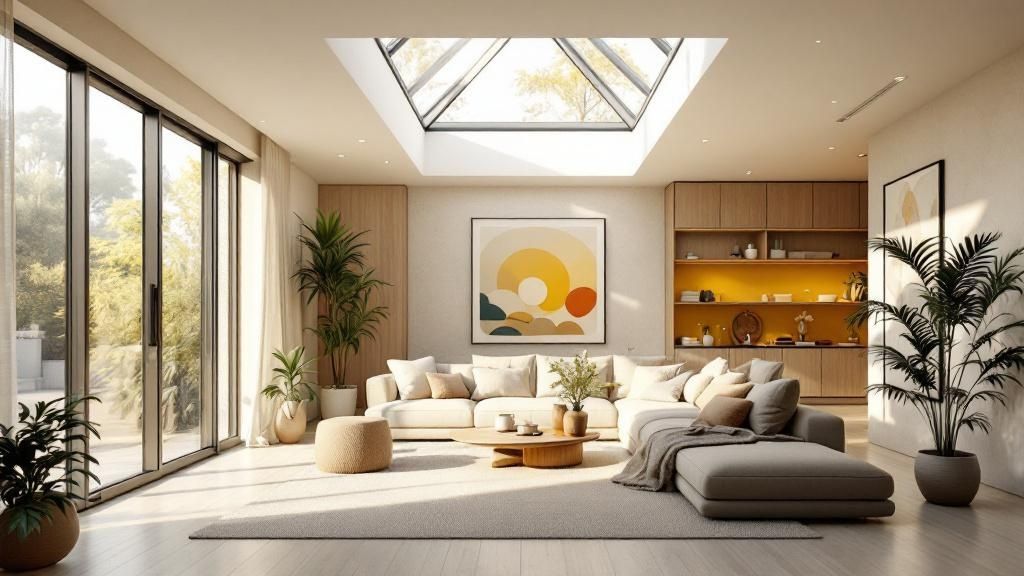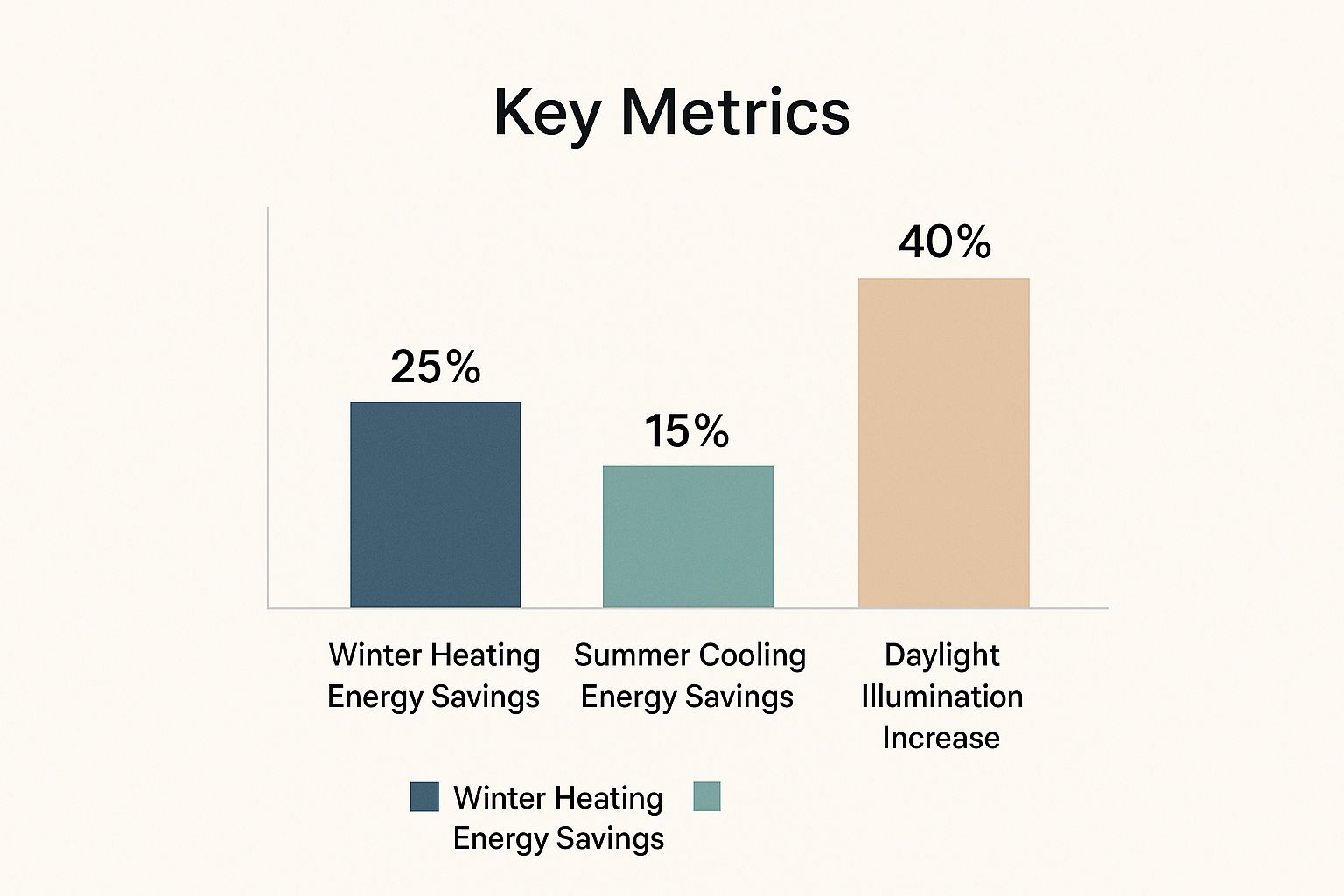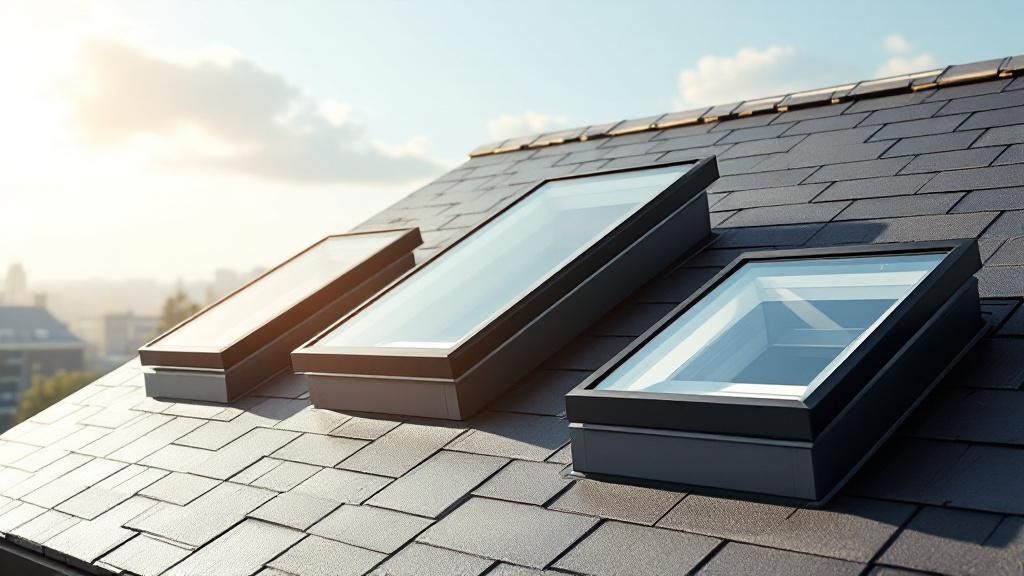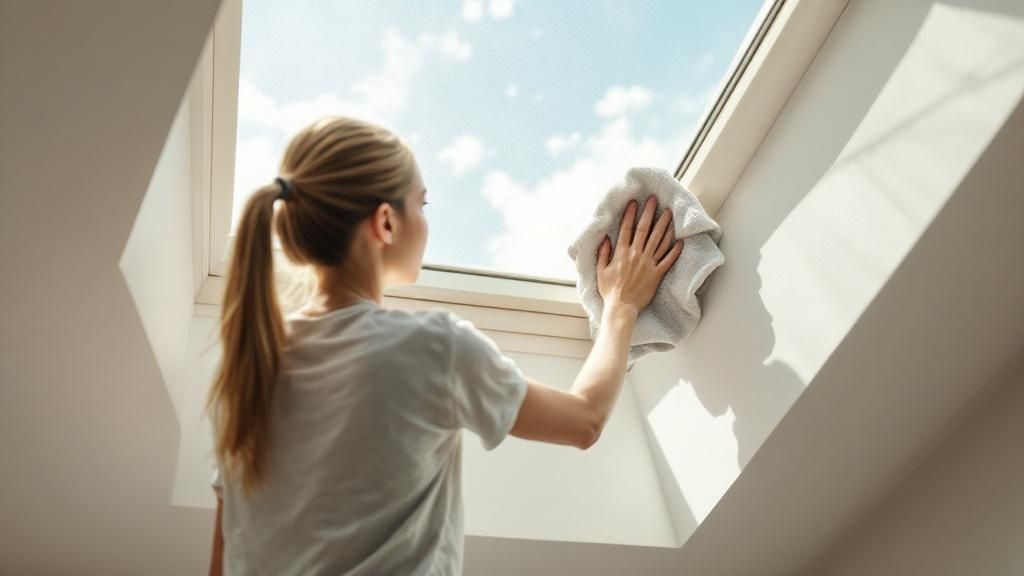
Understanding What Really Matters For Skylight Performance

Skylights are a wonderful way to brighten your home and potentially lower your energy bills. However, it’s important to remember that not all skylights are made equal. Some installations can actually increase your energy usage if they aren’t properly planned and installed. This is why understanding what makes a skylight energy-efficient is so important for Australian homeowners.
Key Factors Influencing Skylight Performance
Several key factors influence how well a skylight contributes to energy savings.
- Glazing: The type of glass used is critical. Double glazing can dramatically reduce heat transfer. This helps keep your home cooler in the summer and warmer in the winter.
- Frame Material: Frames constructed from thermally efficient materials, such as aluminum, minimize heat conduction. Black powder-coated frames can also help absorb heat, further reducing the heat transferred into your home.
- Size and Placement: The size of your skylight in relation to the room’s size, and where it’s placed on your roof, has a direct impact on its energy performance. An overly large skylight can lead to overheating, while poor placement can make it less effective.
- Ventilation: Skylights with ventilation allow for natural airflow, reducing the need for air conditioning. Features like rain sensors ensure the skylight closes automatically if it rains, protecting your home from water damage.
- Blinds and Shades: Automated blinds or shades give you more control over the amount of sunlight entering your home. This helps minimize heat gain, especially during the summer months.
The Window Energy Rating Scheme (WERS) in Australia rigorously assesses skylight products for their impact on home energy consumption across the country’s diverse climates. WERS rates skylights for both heating and cooling performance, using a star rating system that lets consumers compare products. For example, high-performing skylights can earn up to 5 stars for summer cooling and 4.5 stars for winter heating available in Australia.
You can find more in-depth information on various aspects of skylight performance here: How to master skylight energy efficiency.
Maximising Your Investment
Understanding the long-term costs is crucial. Choosing energy-efficient skylights may require a larger initial investment, but it’s an investment that can save you money over time by lowering your energy bills. Considering the factors mentioned above and selecting the right skylight for your particular needs and climate zone is key to maximizing your return on investment. By doing so, you’ll not only enjoy a brighter, more comfortable home, but you’ll also save money. Thinking about future costs? You might find this article helpful: Planning for future expenses.
Decoding WERS Ratings Without The Technical Jargon

The infographic above illustrates how energy-efficient skylights can significantly improve your home. Imagine saving 25% on winter heating, 15% on summer cooling, and enjoying a 40% increase in natural light. These compelling numbers show how the right skylight can transform both your energy bills and your living space. But how do you find the “right” skylight? It starts with understanding the Window Energy Rating Scheme (WERS).
Understanding U-Value and SHGC
Two crucial elements of the WERS rating are the U-value and the Solar Heat Gain Coefficient (SHGC). The U-value measures how effectively a skylight prevents heat transfer. A lower U-value means better insulation. Think of it like a high-quality thermos, keeping your drink at the perfect temperature. A U-value of 2.5 W/m²K is superior to a U-value of 4.0 W/m²K.
The SHGC, on the other hand, measures how much solar heat passes through the skylight. In Australia’s warmer climates, a lower SHGC is typically preferable to minimize summer heat gain. However, in cooler areas, a higher SHGC might be beneficial for capturing winter sun and passively heating your home.
WERS Star Ratings Simplified
WERS uses a star rating system (0-6 stars) to summarize a skylight’s energy performance. More stars generally indicate better energy efficiency. However, it’s essential to remember that the star rating combines both U-value and SHGC. So, consider both values individually to ensure they align with your climate and specific needs.
To help illustrate the differences between skylight models, let’s look at a comparison table:
This table presents a comparison of WERS star ratings, U-values, and SHGC for popular skylight models available in Australia. This data allows you to quickly assess the energy performance of various options and choose the best fit for your home.
WERS Star Rating Comparison for Popular Skylight Models
Performance comparison showing star ratings, U-values, and SHGC for top-rated skylights in Australia
| Skylight Model | Summer Stars | Winter Stars | U-Value (W/m²K) | SHGC |
|---|---|---|---|---|
| Model A | 4 | 3 | 2.8 | 0.45 |
| Model B | 3 | 4 | 3.2 | 0.55 |
| Model C | 5 | 2 | 2.5 | 0.35 |
| Model D | 2 | 5 | 3.5 | 0.65 |
As this table demonstrates, different models prioritize different aspects of energy performance. Model C excels in summer performance with a high summer star rating and low SHGC, while Model D is better suited for cooler climates with its high winter star rating and higher SHGC. It’s important to analyze these factors in relation to your specific needs.
Beyond the Stars: Choosing Wisely
While WERS ratings are a valuable tool, consider other factors like skylight size, placement, and features such as blinds or ventilation. These elements contribute to overall energy efficiency. The right combination can maximize your energy savings and ensure long-term comfort.
Real Australian Homes, Real Energy Savings Results

Skylight energy efficiency offers tangible benefits for homeowners across Australia. From Brisbane to Perth, families are saving money on their energy bills thanks to well-planned skylight installations. But how exactly does this work? This section explores real-world examples, showcasing how skylights translate into real energy savings.
Success Stories From Across The Country
Real-life examples clearly demonstrate the potential of energy-efficient skylights. In Townsville, one homeowner installed two Low-E glass ventilated skylights with rain sensors and automated blinds. The result was a 15% reduction in their monthly energy bills during the Queensland summer. This improvement primarily came from decreased reliance on air conditioning and artificial lighting. These practical changes highlight how the right skylight features can directly impact energy use. Learn more about energy efficiency with skylights in Queensland’s tropical climate here. Similar results are appearing across Australia as more people discover the advantages of strategically placed, quality skylights.
Melbourne Marvel: Transforming Homes With Light
Melbourne’s variable temperatures present unique challenges, and homeowners are discovering the year-round benefits of skylights. During winter, strategically placed skylights capture valuable sunlight, reducing the need for heating. In summer, features like automated blinds and ventilation help prevent overheating and minimize the use of air conditioning. These additions allow Melbourne residents to enjoy natural light while maintaining a comfortable indoor temperature. This balanced approach shows how skylight energy efficiency can be adapted to different climates and individual requirements.
Tailoring Solutions for Different Homes
The impact of skylights on energy bills depends on several factors, including home size, location, and energy consumption habits. A smaller home in a mild climate might see a smaller percentage decrease in energy bills compared to a larger home in a hotter region. However, small savings add up over time, especially when combined with other energy-saving strategies. Combining skylights with proper insulation and energy-efficient appliances can create a significant impact, substantially lowering overall energy consumption. This approach to energy efficiency shows that skylights are a valuable component of a larger energy-saving plan.
Maximising Skylight Energy Efficiency: Placement and Features
The placement of your skylights is key to optimizing their energy-saving potential. South-facing skylights in the Southern Hemisphere, for example, maximize winter solar gain and minimize summer overheating. East and west-facing skylights provide balanced natural light throughout the day. Features like Low-E coatings, automated blinds, and ventilation systems further enhance efficiency and control light and heat transfer. By considering these elements, homeowners can ensure their skylights contribute to a more comfortable and energy-efficient home.
Getting The Size And Placement Right From Day One
Picking the perfect size and spot for your skylights is a game-changer for energy efficiency. A skylight that’s too big or poorly placed can actually increase your energy bills. Let’s explore why getting it right from the start is so important.
The Importance of the Skylight-to-Floor Area Ratio
Australia’s National Construction Code offers helpful guidelines on skylight sizing, balancing natural light with energy performance. A key concept is the skylight-to-floor area ratio, often recommended to be between 1-5%.
This ratio helps avoid overheating in summer and heat loss in winter. For most homes, 3-5% provides plenty of daylight. However, well-lit spaces might only need 1-2%. Modern Australian skylights are designed for top-notch thermal performance, often boasting U-values below 3.0 W/m²K and SHGC below 0.5. For more detailed information, check out yourhome.gov.au.
Placement: Optimising for Light and Energy
Where you put your skylight significantly impacts its energy efficiency. In the Southern Hemisphere, south-facing skylights are generally preferred for maximizing winter sun and minimizing summer heat. East- or west-facing options offer balanced light throughout the day.
Positioning skylights to avoid direct summer sun reduces the need for air conditioning. Strategic placement for winter sun can passively warm your home, lessening reliance on heating. Consider your room layout, roof orientation, and climate zone for optimal results.
Case Studies: Learning From Real Examples
Real-world scenarios highlight the importance of proper sizing and placement. A massive skylight in a tiny room can lead to overheating, stressing your cooling system. Conversely, a small skylight in a large room won’t provide sufficient natural light, increasing your reliance on artificial lighting.
Think of a small bathroom with a huge skylight – scorching in summer! Or a tiny skylight in a spacious living room – barely a flicker of illumination.
Modern Solutions: Overcoming Traditional Limitations
Luckily, skylight technology has advanced considerably. Double-glazing, Low-E coatings, and automated blinds give you more control over light and heat. These features allow for larger skylights without compromising energy efficiency.
By considering size, placement, and modern features, you can ensure your skylight creates a brighter, more comfortable, and energy-efficient home. Understanding these factors helps you avoid costly mistakes and fully enjoy the benefits of natural light.
Smart Features That Actually Deliver Energy Savings

Choosing the right skylight involves more than just dimensions and positioning. Smart features can significantly improve a skylight’s energy performance, resulting in substantial savings on your energy costs. Let’s explore some essential technologies that make for a more comfortable and economical home.
Low-E Coatings: Reflecting Heat for Year-Round Comfort
Low-E coatings are a significant advancement in skylight energy efficiency. These virtually invisible coatings reflect infrared radiation. This means your home stays cooler in the summer by reflecting the sun’s heat away. In the winter, the coatings reflect interior heat back inside.
Think of Low-E coatings as a mirror for heat, bouncing unwanted energy away while maintaining the desired temperature indoors. This can dramatically reduce your reliance on heating and cooling systems, resulting in noticeable savings on your energy bills.
Automated Ventilation: Breathing Easy and Saving Energy
Good ventilation is crucial for a comfortable and healthy indoor environment. Automated ventilation in skylights optimizes this by reacting to temperature and humidity.
Automated vents can open to release trapped hot air during the summer, lessening the need for air conditioning. This natural cooling method circulates fresh air while minimizing energy use.
Smart Controls: Optimizing Performance with Automation
Connecting your skylight to smart home technology offers greater control. Smart controls let you adjust blinds, vents, and even the skylight’s opening and closing remotely or on a schedule.
This allows you to optimize your skylight’s performance for various times of day and weather conditions, maximizing energy efficiency and comfort. You can program your skylight to close automatically during peak heat, preventing unwanted heat gain.
Rain Sensors and Temperature-Responsive Blinds: Adapting to the Elements
Skylights with rain sensors and temperature-responsive blinds are ideal for unpredictable weather. Rain sensors automatically close the skylight when it rains, preventing water damage.
Temperature-responsive blinds adjust automatically according to sunlight, preventing overheating and maximizing daylight. These features create an adaptable and efficient skylight system, ensuring optimal performance year-round.
Future-Proofing Your Investment: Emerging Technologies to Consider
Skylight technology is constantly advancing. Dynamic glazing, which automatically tints based on sunlight, and integrated solar panels that generate electricity are two interesting developments.
These emerging technologies offer the potential for even greater energy savings and more control. You can enjoy the benefits of natural light while lessening your environmental footprint. Learn more about energy-efficient skylight solutions and improve your home’s lighting and lower your energy bills.
Installation Secrets That Maximize Long-Term Performance
A high-quality skylight can dramatically improve your home’s energy efficiency. However, correct installation is key to realizing these benefits. Many contractors overlook critical details that can impact long-term performance and energy savings. This section explores those crucial installation factors that can make or break your skylight’s effectiveness, from structural considerations to weatherproofing techniques.
Structural Considerations: Minimizing Thermal Bridging
Thermal bridging happens when a highly conductive material, like metal, creates a path for heat transfer. This can negate your skylight’s insulation, leading to energy loss. For instance, a poorly installed skylight frame directly contacting your roof’s framing creates a thermal bridge. This allows heat to escape during winter and enter during summer. Proper insulation around the skylight frame minimizes thermal bridging, ensuring optimal performance.
Weatherproofing: Preventing Air Leaks and Moisture
Effective weatherproofing is vital for maximizing energy efficiency. Air leaks around the skylight frame can significantly impact heating and cooling costs. Inadequate sealing can also lead to moisture problems, damaging your ceiling and insulation. A well-sealed skylight protects against drafts and moisture, preventing these issues and maintaining a comfortable indoor environment.
Orientation Strategies for Australian Climates
Skylight orientation plays a crucial role in optimizing energy performance. South-facing skylights are generally best in Australia for maximizing winter solar gain while minimizing summer overheating. East and west-facing skylights can also be effective, providing balanced natural light throughout the day. The ideal orientation depends on your climate zone and home layout. Learn more in our article about How to master skylight installation.
Avoiding Common Installation Pitfalls
Several common installation mistakes can compromise skylight energy efficiency. Let’s explore a few key examples:
- Incorrect flashing: Flashing directs water away from the skylight. Improper installation can lead to leaks and water damage.
- Poor insulation: Insufficient insulation around the skylight frame can increase heat transfer and reduce energy savings.
- Inadequate sealing: Gaps around the frame allow air leaks, impacting heating and cooling efficiency.
The following table summarizes how various installation factors can influence a skylight’s energy performance and the potential savings you can achieve. It also highlights best practices to ensure optimal results.
Installation Factors Impact on Energy Efficiency
| Installation Factor | Impact on Efficiency | Potential Energy Savings | Best Practice |
|---|---|---|---|
| Thermal Bridging | Reduced efficiency due to heat transfer | Lower savings | Properly insulate around the skylight frame |
| Air Leaks | Decreased efficiency due to drafts | Reduced savings | Thoroughly seal all gaps and cracks |
| Moisture Infiltration | Damage to insulation, reduced efficiency | Significant loss of potential savings | Ensure proper flashing and weatherproofing |
| Incorrect Orientation | Suboptimal solar gain | Lower than expected savings | Choose south-facing orientation in Australia (or east/west for balanced light) |
As the table illustrates, addressing these key installation factors is crucial for maximizing the energy efficiency of your skylight and achieving the greatest potential savings.
Choosing Qualified Installers
Selecting a qualified installer is paramount for proper installation and long-term performance. Look for installers experienced in energy-efficient installations and familiar with relevant building codes. A knowledgeable installer understands the importance of thermal bridging, weatherproofing, and proper orientation. They can answer your questions about maximizing energy efficiency and offer advice tailored to your home and climate.
Post-Installation Optimization and Maintenance
Even with professional installation, ongoing maintenance is crucial for maintaining peak energy efficiency. Regularly cleaning your skylight and checking for leaks can prevent future problems. Consider adding automated blinds or shades to control sunlight, further optimizing energy performance. This proactive approach ensures your skylight continues delivering optimal performance and energy savings for years to come.
Making The Numbers Work: Costs, Savings, and Realistic ROI
Investing in energy-efficient skylights is a wise decision, but understanding the financial implications is key to making informed choices. This involves carefully assessing the costs and weighing them against the long-term value and potential return on investment (ROI).
Understanding the Initial Investment
The upfront cost of energy-efficient skylights varies based on several factors, including size, glazing, features, and installation complexity. While higher quality often comes with a higher initial price, it’s important to evaluate options based on total value rather than just upfront expenses. Think of it like buying a car: a more fuel-efficient model might have a higher sticker price, but the savings at the gas pump accumulate over time.
Calculating Realistic Energy Savings
Figuring out your potential energy savings involves considering your specific circumstances. Factors such as home size, current energy bills, climate, and skylight placement all contribute. For example, a home in a warmer climate will likely see greater cooling savings than a home in a cooler climate. You might be interested in: How to master skylight insulation. Even small savings add up over time, particularly when combined with other energy-saving strategies.
Rebates and Incentives: Boosting Your ROI
Many government and utility companies offer rebates and incentives for energy-efficient upgrades, including skylights. These programs can substantially lower your initial investment and shorten the payback period. Researching available rebates in your area can make energy-efficient skylights an even more appealing financial decision. These incentives can often be the deciding factor, making an upgrade more budget-friendly and accelerating your return on investment.
Realistic Payback Periods
The payback period, or the time it takes for your energy savings to equal the initial cost, depends on your particular situation. However, many homeowners see a reasonable payback period, often within a few years, particularly when rebates and incentives are taken into account. This timeframe highlights the true financial benefits of energy-efficient skylights.
Increasing Property Value: A Long-Term Benefit
Beyond energy savings, efficient skylights can also boost your property value. Natural light is a sought-after feature for potential buyers, making your home more desirable and potentially raising its market price. This increased value represents a long-term financial advantage that further enhances the overall ROI of your skylight investment.
Ready to brighten your home and lower your energy bills? Explore the selection of high-quality, energy-efficient skylights from Vivid Skylights and discover how we can enhance your living space while reducing your environmental footprint.
